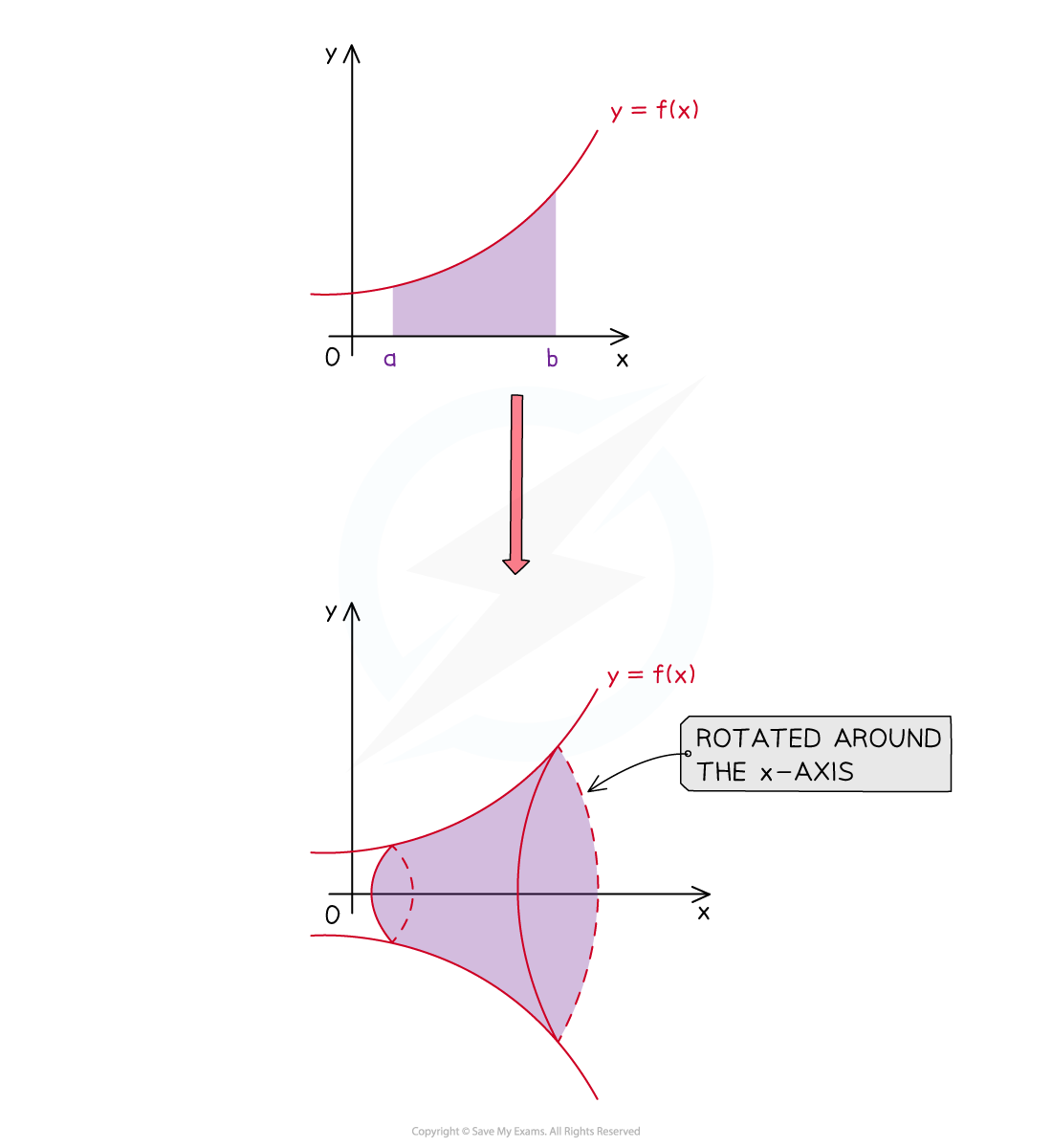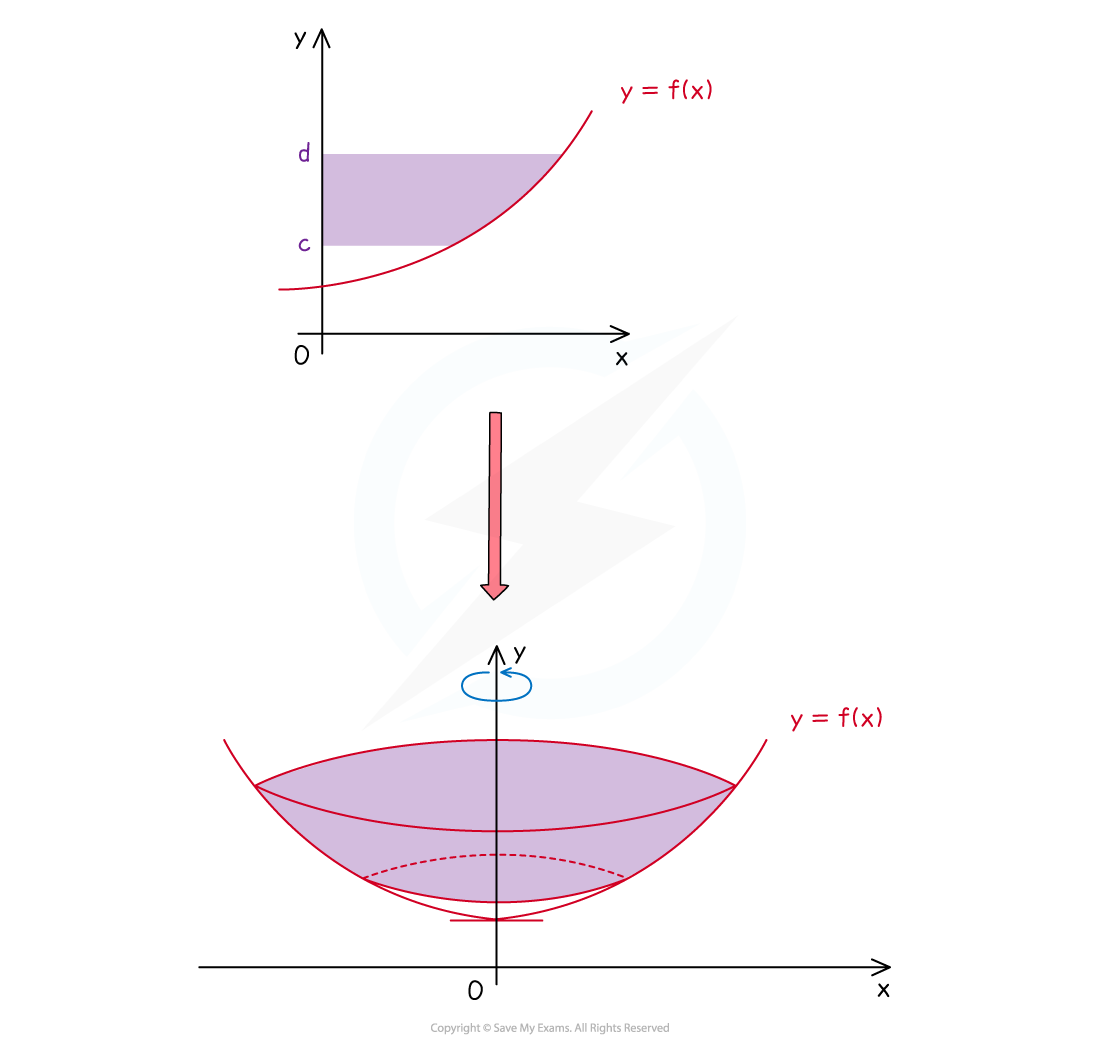Volumes of Revolution (Edexcel A Level Further Maths): Revision Note
Exam code: 9FM0
Volumes of revolution around the x-axis
What is a volume of revolution around the x-axis?
A solid of revolution is formed when an area bounded by a function
(and other boundary equations) is rotated 360° around the x-axis
A volume of revolution is the volume of this solid formed

Example of a solid of revolution that is formed by rotating the area bounded by the function , the lines
and
and the
-axis
about the
-axis
How do I find the volume of revolution around the x-axis?
To find the volume of revolution created when the area bounded by the function
, the lines
and
, and the x-axis is rotated 360° about the x-axis use the formula
The formula may look complicated or confusing at first due to the y and dx
remember that y is a function of x
once the expression for y is substituted in, everything will be in terms of x
π is a constant so you may see this written either inside or outside the integral
This is not given in the formulae booklet
The formulae booklet does list the volume formulae for some common 3D solids – it may be possible to use these depending on what information about the solid is available
Where does the formula for the volume of revolution come from?
When you integrate to find the area under a curve you can see the formula by splitting the area into rectangles with small widths
The same method works for volumes
Split the volume into cylinders with small widths
The radius will be the y value
The width will be a small interval along the x-axis δx
The volume can be approximated by the sum of the volumes of these cylinders
The limit as δx goes to zero can be found by integration - just like with areas
How do I solve problems involving volumes of revolution around the x-axis?
Visualising the solid created is helpful
Try sketching some functions and their solids of revolution to help
STEP 1 Square y
Do this first without worrying about π or the integration and limits
STEP 2 Identify the limits a and b (which could come from a graph)
STEP 3 Use the formula by evaluating the integral and multiplying by π
The answer may be required in exact form (leave in terms of π)
If not, round to three significant figures (unless told otherwise)
Trickier questions may give you the volume and ask for the value of an unknown constant elsewhere in the problem
Examiner Tips and Tricks
To help remember the formula note that it is only
- volume is 3D so you may have expected a cubic expression
If rotating a single point around the x-axis a circle of radius would be formed
The area of that circle would then be
Integration then adds up the areas of all circles between a and b creating the third dimension and volume (In 2D, integration creates area by adding up lots of 1D lines)
Worked Example
Find the volume of the solid of revolution formed by rotating the region bounded by the graph of , the coordinate axes and the line
by
radians around the
-axis. Give your answer as an exact multiple of
.

Volumes of revolution around the y-axis
What is a volume of revolution around the y-axis?
A solid of revolution is formed when an area bounded by a function
(and other boundary equations) is rotated 360° around the y-axis
A volume of revolution is the volume of this solid formed

Example of a solid of revolution that is formed by rotating the area bounded by the function , the lines
and
and the
-axis
about the
-axis
How do I find the volume of revolution around the y-axis?
To find the volume of revolution created when the area bounded by the function
, the lines
and
, and the y-axis is rotated 360° about the y-axis use the formula
Note that although the function may be given in the form
it will first need rewriting in the form
This is not given in the formulae booklet
How do I solve problems involving volumes of revolution around the y-axis?
Visualising the solid created is helpful
Try sketching some functions and their solids of revolution to help
STEP 1 Rearrange
into the form
(if necessary)
This is finding the inverse function
STEP 2 Square x
Do this first without worrying about π or the integration and limits
STEP 3 Identify the limits c and d (which could come from a graph)
STEP 4 Use the formula by evaluating the integral and multiplying by π
The answer may be required in exact form (leave in terms of π)
If not, round to three significant figures (unless told otherwise)
Trickier questions may give you the volume and ask for the value of an unknown constant elsewhere in the problem
Examiner Tips and Tricks
Double check questions to ensure you are clear about which axis the rotation is around
Separating the rearranging of
into
and the squaring of x is important for maintaining accuracy
In some cases it can seem as though x has been squared twice
Worked Example
Find the volume of the solid of revolution formed by rotating the region bounded by the graph of and the coordinate axes by
radians around the
-axis. Give your answer to three significant figures.

Volumes of revolution using parametric equations
What is parametric volumes of revolution?
Solids of revolution are formed by rotating functions about the x-axis or the y-axis
Here though, rather than given y in terms of x, both x and y are given in terms of a parameter, t
Depending on the nature of the functions f and g it may not be convenient or possible to find y in terms of x
How do I find volumes of revolution when x and y are given parametrically?
The aim is to replace everything in the ‘original’ integral so that it is in terms of t
For the ‘original’ integral
or
and parametric equations given in the form
and
use the following process
STEP 1: Find dx or dy in terms of t and dt
or
STEP 2: If necessary, change the limits from x values or y values to t values using
or
or
STEP 3: Square y or x
or
Do this separately to avoid confusing when putting the integral together
STEP 4: Set up the integral, so everything is now in terms of t, simplify where possible and evaluate the integral to find the volume of revolution
(if around x-axis) or
(if around y-axis)
Examiner Tips and Tricks
Avoid the temptation to jump straight to STEP 4
There could be a lot to change and simplify in exam style problems
Doing each step carefully helps maintain high levels of accuracy
Worked Example
The curve C is defined parametrically by and
. C is rotated 360° about the x-axis between the values of
and
. Show that the volume of the solid of revolution generated by this rotation is
cubic units where
and
are integers to be found.


Unlock more, it's free!
Did this page help you?